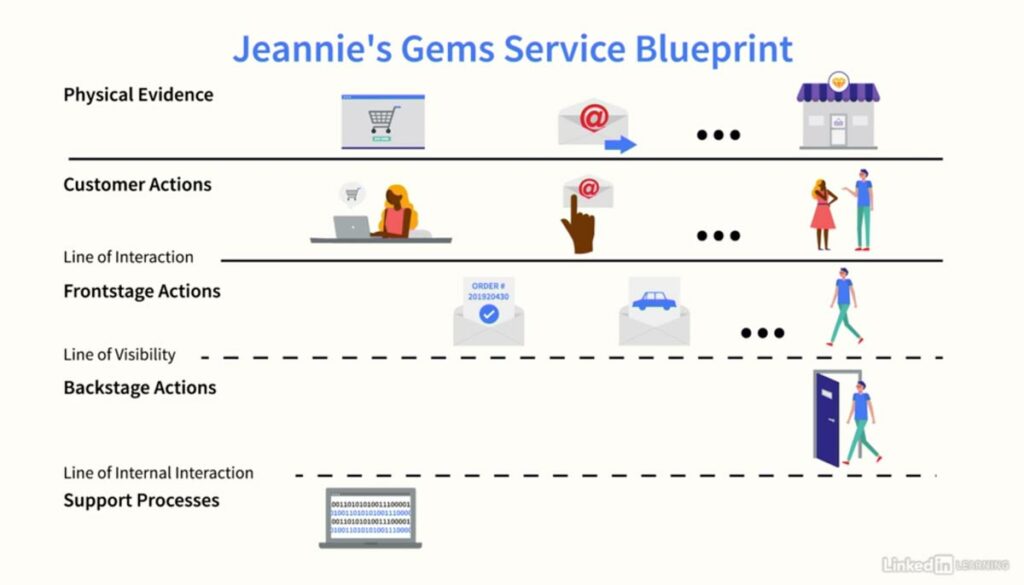How can leaders best prepare for the next normal? Service blueprinting may be the answer.
Organizations are planning for a phase of reopening including determining how customers can safely make purchases to how many employees can really come back to certain workplaces.
It’s no small task and it’s really a new experience for everyone. Most workplaces weren’t designed to consider a pandemic and customer experiences weren’t designed with hyper consciousness around health and safety from an invisible virus.
Architects rely on blueprints to understand structures and determine critical choices like where to bust down a wall. Experience leaders can use this same philosophy and approach with service blueprints.
Service blueprints are designed to map out the future experience for customers as well as the backend processes and systems to make the experience happen.
This might sound like a customer journey map, but there are a few distinctions.
The service blueprint conveys what people, processes, systems and communications are required to deliver on the best experience for your customer.
As an example, consider how a customer orders groceries using an app.
A customer journey map would show the experience your customer has or the experience you’d like to design. But those groceries don’t show up magically, do they?
A service blueprint considers the customer experience, then drills down to the “backstage” events.
And on and on it goes!
There are several steps to building a service blueprint, and the best ones include nuance and an understanding of the entire end-to-end journey:
For the purposes of this article, let’s focus on the three key steps toward building and using a service blueprint.

Image from Customer Experience: Service Blueprinting online course by Jeannie Walters and Linkedin Learning.
Frontstage actions are all about what the customer sees and interacts with along the journey. This includes experiences like ordering on the app, like in our example.
We can think of Frontstage actions as having two components:
Some customer actions are independent of employee actions. Examples include:
But many customer and employee actions will have multiple points of interaction. Examples of this include:
It’s helpful to track these interactions, and we can do so with a line of interaction, a literal line drawn on our service blueprint that helps us track where these interactions occur.
Here’s a tip that will save you time: When mapping your frontstage actions, use existing resources — like your customer journey map or Net Promoter Score (NPS) feedback — as points of reference for your blueprint.
What happens behind the scenes? Consider:
Backstage actions often include their own “Line of Internal Interaction.” Employees might swipe a credit card and wait for approval from a system, for example.
In this example, the way the system works is not visible to the employee or the customer. But the success of failure of that system has a direct impact on the customer experience.
These processes that affect the customer without direct visibility are referred to as support processes.
Service blueprints help bring all of these points of potential delight or friction into full view.
Service blueprints are more than just documents outlining actions and interactions. They’re tools which can remedy long-standing points of frustration — not only for your customers, but for your team as well.
You can even use your service blueprint to train new employees as they’re brought on.
 I encourage you to take my Linkedin Learning course — Customer Experience: Service Blueprinting — which includes:
I encourage you to take my Linkedin Learning course — Customer Experience: Service Blueprinting — which includes:
The course is $29.99, but included free for Linkedin Learning members. Not a member? You may be able to redeem one month free.
(Disclaimer: Links to Linkedin Learning are affiliate links.)
Moving into the next phase of our shared reality — whatever that may be — means planning for what we know and making accommodations for what we don’t know yet.
Related: How to Build & Maintain Customer Trust During Covid-19
Service blueprints are great for visualizing the experience and the requirements needed to deliver on that. Here are a few ideas for leveraging service blueprints today:
Blueprinting helps build the foundation around what’s needed.
Offering curbside pickup? What does that really require from employees, processes and systems? The blueprint can tell you.
Need to reduce capacity in physical spaces? Create a one-way traffic pattern? Service blueprints can help.
Build a phase one blueprint and then layer on what’s needed for phase two and three and beyond.
Service blueprints are a great resource to think through what’s truly needed to set the right expectations with employees.
With a blueprint, employees could help test experience moments like how long it takes to sanitize a customer area, for example. That time expectation could impact the way customer expectations are set and employee standards are measured.
It’s not unusual for executives to be many layers away from the actual customer experience. They might not have a true understanding of the impact new safety procedures have on the employee and customer experience. Service blueprints can include information like average time required to enlighten executives and others throughout your organization.
Just like journey maps, service blueprints are not about an artifact. They’re there to be a tool and resource.
Now is the perfect time to leverage these tools to do what’s best for your organization, your employees and your customers.
 Need help getting started?
Need help getting started?Whether it’s a quick consult or a complete workshopping series you need, we’re here to partner with you.
 Jeannie is an award-winning customer experience expert, international keynote speaker, and sought-after business coach who is trailblazing the movement from “Reactive Customer Service” to “Proactive Customer and Employee Experience.” More than 500,000 people have learned from her CX courses on LinkedIn Learning, and her insights have been featured in Forbes, The Chicago Tribune, The Wall Street Journal and NPR.
Get Jeannie’s insights in your inbox each week by subscribing to The Weekly Win and follow her on LinkedIn, Instagram and YouTube.
Jeannie is an award-winning customer experience expert, international keynote speaker, and sought-after business coach who is trailblazing the movement from “Reactive Customer Service” to “Proactive Customer and Employee Experience.” More than 500,000 people have learned from her CX courses on LinkedIn Learning, and her insights have been featured in Forbes, The Chicago Tribune, The Wall Street Journal and NPR.
Get Jeannie’s insights in your inbox each week by subscribing to The Weekly Win and follow her on LinkedIn, Instagram and YouTube.